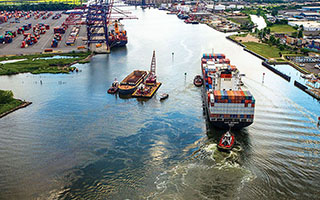The Port of New York-New Jersey saw job growth of 13% between 2012 and 2014, generating more than 190,000 direct jobs across the region, $21 billion in personal income and $53.5 billion in business income, according to a new report prepared for the New York Shipping Association Inc.
A slowly recovering U.S. economy, increasing international trade, and worries over labor unrest in West Coast ports all helped drive more traffic to the Northeast, according to the report prepared by A. Strauss-Wieder Inc., Westfield, N.J.
“Containerized cargo movements grew as the national economy recovered, international trade expanded and shippers shifted cargo movements away from the West Coast port uncertainties,” the report stated. “International bulk movements of commodities, such as petrochemicals, decreased as use of domestic crude oil increased.”
New York-New Jersey is the nation’s third-busiest port and ranks second in value. While vehicles processed through the port on RO/RO vessels declined slightly, port officials foresee growth in 2015, the report says. The NYSA’s own monthly tallies for 2015 indicate the bi-state port could be on track to see a 13% growth in container traffic compared to 2014.
Much of the job growth came in supply chain and warehouse businesses that get their goods through the port, and that network now extends as far west as Pennsylvania’s Lehigh Valley, the report said. It’s a far different landscape than measured in a 1993 economic impact study that found just $6.2 billion in personal income from the port.
That was before years of harbor and channel deepening projects overseen by the Corps of Engineers, continuing today with the dredging of the Arthur Kill channel between New York and New Jersey to 50’ depth.
Along with the increased dredging, ship assist and tow work from port growth, the workboat sector will see even more intra-harbor work evolving in the next few years.
New York City is on an ambitious course to expand low-cost commuter ferry service between Manhattan and other boroughs, and reactivate Brooklyn’s once-thriving marine terminals to deliver cargo directly into the city.




